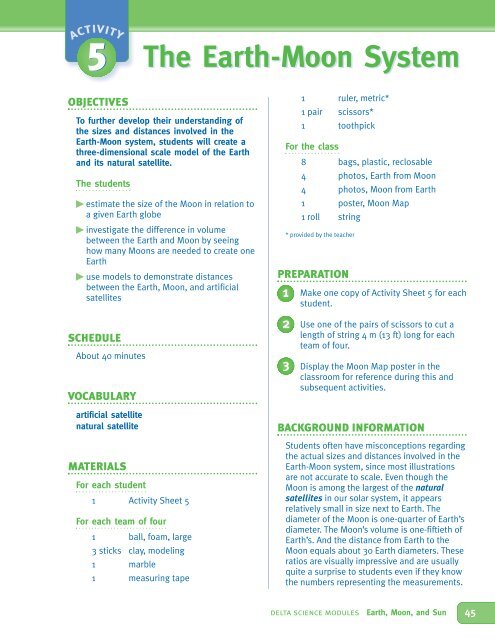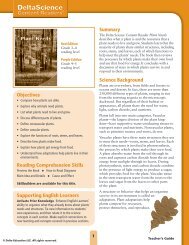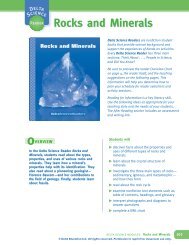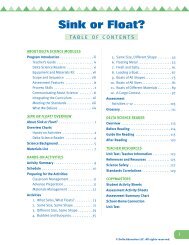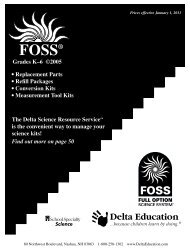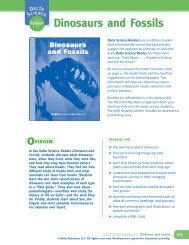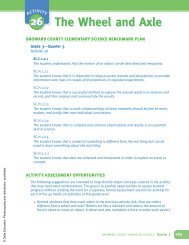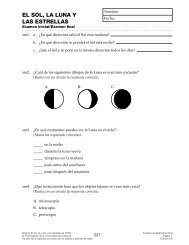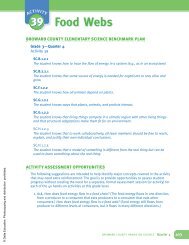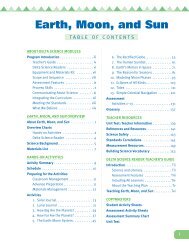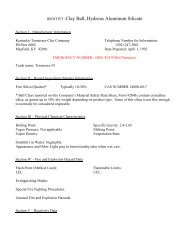The Earth-Moon System The Earth-Moon System - Delta Education
The Earth-Moon System The Earth-Moon System - Delta Education
The Earth-Moon System The Earth-Moon System - Delta Education
You also want an ePaper? Increase the reach of your titles
YUMPU automatically turns print PDFs into web optimized ePapers that Google loves.
activity5<strong>The</strong> <strong>Earth</strong>-<strong>Moon</strong> <strong>System</strong>OBJECTIVESTo further develop their understanding ofthe sizes and distances involved in the<strong>Earth</strong>-<strong>Moon</strong> system, students will create athree-dimensional scale model of the <strong>Earth</strong>and its natural satellite.<strong>The</strong> students estimate the size of the <strong>Moon</strong> in relation toa given <strong>Earth</strong> globe investigate the difference in volumebetween the <strong>Earth</strong> and <strong>Moon</strong> by seeinghow many <strong>Moon</strong>s are needed to create one<strong>Earth</strong> use models to demonstrate distancesbetween the <strong>Earth</strong>, <strong>Moon</strong>, and artificialsatellitesSCHEDULEAbout 40 minutesVOCABULARYartificial satellitenatural satelliteMATERIALSFor each student1 Activity Sheet 5For each team of four1 ball, foam, large3 sticks clay, modeling1 marble1 measuring tape1 ruler, metric*1 pair scissors*1 toothpickFor the class8 bags, plastic, reclosable4 photos, <strong>Earth</strong> from <strong>Moon</strong>4 photos, <strong>Moon</strong> from <strong>Earth</strong>1 poster, <strong>Moon</strong> Map1 roll string* provided by the teacherPREPARATION123Make one copy of Activity Sheet 5 for eachstudent.Use one of the pairs of scissors to cut alength of string 4 m (13 ft) long for eachteam of four.Display the <strong>Moon</strong> Map poster in theclassroom for reference during this andsubsequent activities.BACKGROUND INFORMATIONStudents often have misconceptions regardingthe actual sizes and distances involved in the<strong>Earth</strong>-<strong>Moon</strong> system, since most illustrationsare not accurate to scale. Even though the<strong>Moon</strong> is among the largest of the naturalsatellites in our solar system, it appearsrelatively small in size next to <strong>Earth</strong>. <strong>The</strong>diameter of the <strong>Moon</strong> is one-quarter of <strong>Earth</strong>’sdiameter. <strong>The</strong> <strong>Moon</strong>’s volume is one-fiftieth of<strong>Earth</strong>’s. And the distance from <strong>Earth</strong> to the<strong>Moon</strong> equals about 30 <strong>Earth</strong> diameters. <strong>The</strong>seratios are visually impressive and are usuallyquite a surprise to students even if they knowthe numbers representing the measurements.delta science modules <strong>Earth</strong>, <strong>Moon</strong>, and Sun 45
4Guiding the ActivityHave students measure the string with theirmeasuring tapes and record its length ontheir activity sheets. Ask, How did the actualscale distance between <strong>Earth</strong> and <strong>Moon</strong>compare with your predictions?Write satellite on the board. Ask, What is asatellite?Ask, Does anyone know the name of thefirst satellite to orbit <strong>Earth</strong>?Write natural satellite and artificial satelliteon the board. Explain that the <strong>Moon</strong> is anatural satellite. But point out that <strong>Earth</strong> alsohas many smaller manufactured satellites,or artificial satellites, that are used forcommunication, weather monitoring, andother data collection purposes.Have students predict on their activity sheetshow far from <strong>Earth</strong> most artificial satellitestravel.<strong>The</strong>n have teams take the tiniest dot of claythey can from their model <strong>Earth</strong> and hold itbetween <strong>Earth</strong> and the <strong>Moon</strong>, 20 cm (8 in.)from <strong>Earth</strong>. Explain that the position of thisbit of clay represents the altitude of some ofthe most distant <strong>Earth</strong> satellites! (See Figure5-3 for an accurate distance model of <strong>Earth</strong>’ssatellites.)Additional InformationAllow students time to express their surpriseor other responses. Students may beinterested to know that the true diameter of<strong>Earth</strong> is about 12,800 km (8,000 mi) and themean distance from <strong>Earth</strong> to the <strong>Moon</strong> isabout 380,000 km (230,000 mi).Students may know that a satellite is anobject that orbits a planet.Students may answer with the name of anearly artificial satellite, but probably will saythat they do not know. <strong>The</strong> answer actually isthe <strong>Moon</strong>.Approximately 3,000 artificial satellites arecurrently in orbit around <strong>Earth</strong>.Each team also can hold up the <strong>Earth</strong> modeland a tiny speck of clay to demonstrate ateam prediction.This distance corresponds to an altitude ofabout 35,000 km (22,000 mi) and is thedistance of certain satellites that orbit <strong>Earth</strong>at the same rate at which <strong>Earth</strong> spins and,therefore, that maintain their position abovethe same spot on <strong>Earth</strong> at all times. <strong>The</strong> mostcommon satellites of this kind are theweather satellites that produce the picturesseen on television weather reports.the <strong>Earth</strong>, surrounded byartificial satellitesmost distant artificial satellitesthe <strong>Moon</strong>, <strong>Earth</strong>’snatural satellite Figure 5-3. An accurate distance model of <strong>Earth</strong> and its satellites (not accurate to size).delta science modules <strong>Earth</strong>, <strong>Moon</strong>, and Sun 49
Guiding the ActivityTell teams to insert their toothpick into theclay model of <strong>Earth</strong> until less than 5 mm(0.2 in.) extends from the clay. Explain thatthis represents 500 km (310 mi), the heightat which the space shuttle and most othersatellites fly above <strong>Earth</strong>.Ask, How do space shuttle launches compareto the feat of traveling to the <strong>Moon</strong>?Additional InformationAllow students time to discuss this revelationand to revise their drawings to represent thepositions of satellites accurately.<strong>The</strong> Apollo <strong>Moon</strong> missions were the farthesttrips ever made by human beings, more than1,000 times as far as the average spaceshuttle height.R EINFORCEMENTHave students examine the photos of <strong>Earth</strong>from the <strong>Moon</strong> and the <strong>Moon</strong> from <strong>Earth</strong>.Next, ask each student to observe <strong>Earth</strong> fromthe <strong>Moon</strong> and the <strong>Moon</strong> from <strong>Earth</strong> in theirscale models, by positioning their eye closeto the object from which they would view.Discuss why the models look different fromthe photos.<strong>Earth</strong> actually appears about four timeslarger in the <strong>Moon</strong>’s sky than the <strong>Moon</strong>appears in <strong>Earth</strong>’s sky. <strong>The</strong> fact that this isnot the case in the photos is an illusion.<strong>The</strong>re is no lawn chair in the <strong>Moon</strong> shot tohelp us judge the difference in size!SCIENCE NOTEBOOKSHave students place their completedactivity sheets in their science notebooks.C LEANUPPlace one of the clay scale models ondisplay in the classroom throughout theremainder of the module. Put the rest ofthe clay in the plastic bags provided.Return all other materials to the kit.50 activity 5 <strong>The</strong> <strong>Earth</strong>-<strong>Moon</strong> <strong>System</strong>
ConnectionsScience ChallengeChristopher Columbus discovered that steadywinds, now called trade winds, blow fromeast to west in the southern Atlantic and fromwest to east in the northern Atlantic. Prior toColumbus’s discovery, most sailors believedthat winds were due to the whims of gods ordemons. Scientists did not learn why tradewinds exist until two centuries later.Challenge students to research EdmundHalley’s and George Hadley’s work to explainhow <strong>Earth</strong>’s rotation and orientation createthe trade winds.Science and the ArtsPerspective determines the apparent distanceof objects. Display examples of medieval art,created before formal rules for perspectivewere developed, alongside Renaissanceworks that demonstrate perspective.<strong>The</strong>n have team members take turns holdingthe model <strong>Moon</strong> at an appropriate distancefrom <strong>Earth</strong> while other team members viewthe model from various perspectives: a sideview, the viewpoint from <strong>Earth</strong>, the viewpointof someone traveling to the <strong>Moon</strong>, and theviewpoint from the <strong>Moon</strong>.the amount of parallax is greater for objectsclose to the viewer than for distant objects,an object’s distance can be determined by itsparallax.Have students trace two circles near oppositeends of a sheet of paper to represent the<strong>Moon</strong> and <strong>Earth</strong>. <strong>Earth</strong>’s diameter should beabout 2 cm (0.75 in.) and the <strong>Moon</strong>’s, about0.5 cm (0.2 in.). <strong>The</strong>n they should draw a dotbeyond and to one side of the <strong>Moon</strong> torepresent a star and two separate dots on theside of <strong>Earth</strong> facing the <strong>Moon</strong> to representtwo astronomers at different locations. Usinga ruler, students should draw four straightlines, one from each astronomer to the starand one from each astronomer along thecircumference of the <strong>Moon</strong>. Using aprotractor, students should measure theangle between the <strong>Moon</strong> and the star fromthe perspective of each astronomer. What isthe difference—the parallax—between them?<strong>The</strong>n have students tape sheets of papertogether so that the <strong>Moon</strong> can be 60 cm(24 in.) away, its actual scale distance. Howdoes parallax change as the distance to the<strong>Moon</strong> increases?Science and Math<strong>The</strong> distance from <strong>Earth</strong> to the <strong>Moon</strong> wasfirst measured about 2,000 years ago byHipparchus, a Greek astronomer, usingparallax. He and a distant colleague bothmeasured the angle between the <strong>Moon</strong> anda particular star on a particular night.Have students hold a finger near the tip oftheir nose and view it, first closing one eyeand then the other. Have them view an objectacross the room and a distant tree or buildingin the same way. Do the distant views vary byeye as much as the nearby finger? Explainthat the difference between the view with oneeye and the other is called parallax. Becausedelta science modules <strong>Earth</strong>, <strong>Moon</strong>, and Sun 51


